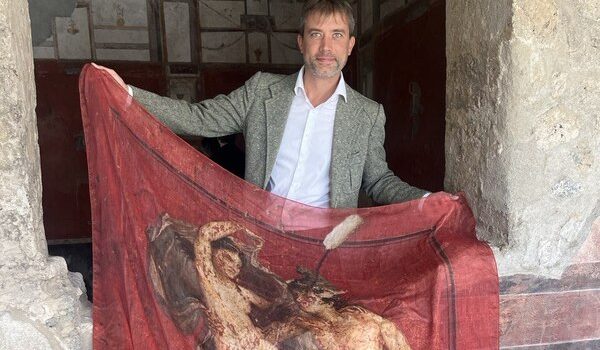POMPEII, ENVIRONMENTAL SUSTAINABILITY AND THE ANCIENT ART OF DYEING WITH THE DYEING PLANTS OF POMPEII
THE POMPEIAN FRESCOES COME TO LIFE ON SUSTAINABLE FABRICS MADE BY CLAUDIO CUTULI
The splendid frescoes in the House of the Vettii come to life on sustainable fabrics made of nettle yarn and natural dyes extracted directly from ancient dyeing plants like those currently being grown in the nursery of the ancient city of Pompeii.
These are the scarves made in three different designs by the master dyer Claudio Cutuli from Intrecci Creativi, an association with a history of generations of artisan dyers and weavers, as part of a partnership with the Archaeological Park of Pompeii. The aim of the initiative is to enhance ancient heritage through an environmentally friendly approach to recovering the traditional materials and techniques of the art of dyeing.
The scarves, which are entirely handmade on ancient looms and dyed with selected and refined raw materials from the plant world, will be on sale worldwide and 50% of the proceeds will be devoted to the restoration of the structures in the Park of Pompeii.
The partnership is one of various initiatives that involve private individuals interacting with the broader project of Azienda agricola Pompei, an agricultural initiative in which the Park has invested. The project is designed to redevelop and enhance numerous green spaces in various sites within the Park – through activities such as olive-growing, wine-making, horticulture, fruit-growing and cereal production, together with beekeeping and animal grazing, woodland re-growth and nursery-gardening - with the aim of safeguarding biodiversity and providing environmental education, respecting the updated interpretation of the agricultural techniques and cultivation methods of the ancient world, respecting the archaeological nature of the sites, and encouraging best practices among the communities in the surrounding territory.
“The art of dyeing is an example of ‘excellence in the craft traditions of Italy,” emphasises Gabriel Zuchtriegel, Director of the Archaeological Park of Pompeii, “and has its roots in ancient Pompeii with its fullonicae (fulleries), the ancient laundries, where everything was eco-friendly and natural. Archaeology in the twenty-first century is also concerned with research into sustainability in terms of the environment, society and management. This partnership is consistent with our strategy geared towards safeguarding and enhancing green spaces in Pompeii which, in many ways, is inseparable from ensuring the protection of, and access to, cultural heritage. We shall therefore work on the use of dyeing plants in Pompeii, but we are also considering setting up workshops and spaces to tell the story of the tradition of this art from ancient fulleries to the present day.”
The scarves depict, in the case of those with a red background, several subjects from the room with the frieze of the “Cupids at work” in the House of the Vettii. More specifically, the frescoes depict the floating figures of Perseus and Andromeda and another pair of cupids who are shown washing and carding (cleaning and untangling) fabrics. The scarves are made using the same dyeing technique used in Roman times, applying dyer’s madder (Rubbia tinctorum) to the nettle yarn for red and for pink, elderberry for black and grey and walnut husk for brown and for natural colouring.
The third subject illustrated on the scarves comes from the Ixion room or the small triclinium, also in the House of the Vettii. It shows a parapet with a theatrical mask and a wicker basket containing musical instruments, while the panel below depicts two biremes (a ship with two banks of oars) and a port in the background.
“For almost 200 years, natural dyeing has been a showpiece of our artisanal products and I believe, especially times like these, there is an essential, crucial link between respect for the environment and weaving, in a sector where trading standards often display a lack of attention to environmental sustainability”, adds the master dyer Claudio Cutuli. “Pompeii offers us an additional opportunity to safeguard the future of the planet and to continue with the intention of leaving to posterity a passion for knowledge of our surroundings, for what we once were and what we wish the future to look like”.


